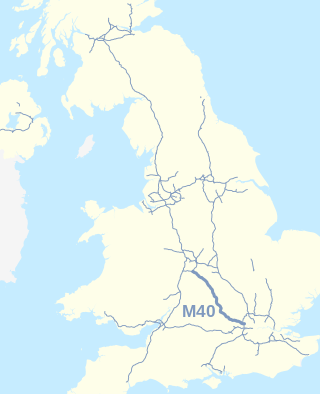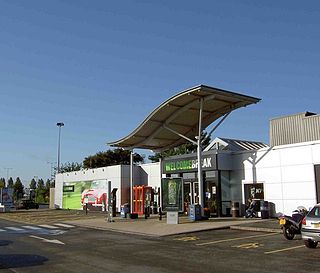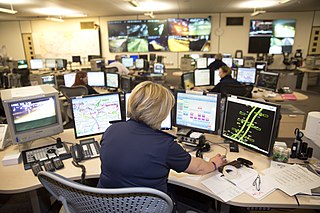
The M1 motorway connects London to Leeds, where it joins the A1(M) near Aberford, to connect to Newcastle. It was the first inter-urban motorway to be completed in the UK; the first motorway in the country was the Preston Bypass, which later became part of the M6.

The M4, originally the London-South Wales Motorway, is a motorway in the United Kingdom running from west London to southwest Wales. The English section to the Severn Bridge was constructed between 1961 and 1971; the Welsh element was largely complete by 1980, though a non-motorway section around Briton Ferry bridge remained until 1993. On the opening of the Second Severn Crossing in 1996, the M4 was rerouted over it.

The M40 motorway links London, Oxford, and Birmingham in England, a distance of approximately 89 miles (143 km).

The M62 is a 107-mile-long (172 km) west–east trans-Pennine motorway in Northern England, connecting Liverpool and Hull via Manchester, Bradford, Leeds and Wakefield; 7 miles (11 km) of the route is shared with the M60 orbital motorway around Manchester. The road is part of the unsigned Euroroutes E20 and E22.

The M5 is a motorway in England linking the Midlands with the South West. It runs from junction 8 of the M6 at West Bromwich near Birmingham to Exeter in Devon. Heading south-west, the M5 runs east of West Bromwich and west of Birmingham through Sandwell Valley. It continues past Bromsgrove, Droitwich Spa, Worcester, Tewkesbury, Cheltenham, Gloucester, Bristol, Portishead, Clevedon, Weston-super-Mare, Bridgwater, Taunton, terminating at junction 31 for Exeter. Congestion on the section south of the M4 is common during the summer holidays, on Friday afternoons and bank holidays.

The A50 is a major trunk road in England between Warrington and Leicester; historically it was also a major route from London to Leicester.

The Selby rail crash was a high-speed rail crash that occurred at Great Heck near Selby, North Yorkshire, England, on the morning of 28 February 2001. An InterCity 225 passenger train operated by Great North Eastern Railway (GNER) travelling from Newcastle to London collided with a Land Rover Defender which had crashed down a motorway embankment onto the railway line. It was consequently derailed into the path of an oncoming freight train, colliding at an estimated closing speed of 142 mph (229 km/h). Ten people were killed, including the drivers of both trains, and 82 were seriously injured. It remains the worst rail disaster of the 21st century in the United Kingdom.

easyBus is a company offering shuttle services between airports and city centers, part of the EasyGroup. It was founded by entrepreneur Stelios Haji-Ioannou in 2003. It initially also offered intercity services within the UK in addition to city to airport low-cost bus transfers.

Newport Pagnell Services is a motorway service station between junctions 14 and 15 of the M1 motorway near Newport Pagnell in the City of Milton Keynes, north Buckinghamshire, England. It is owned and operated by Welcome Break.

Motorway service areas in the United Kingdom and Ireland, also known as services or service stations, are rest areas where drivers can leave a motorway to refuel/recharge, rest, eat and drink, shop or stay in an on-site overnight hotel. The vast majority of motorway services in the UK are owned by one of three companies: Moto, Welcome Break and Roadchef. Smaller operators include Extra, Westmorland and EG Group.

The Milton Keynes Coachway is a Coachway interchange close to junction 14 of the M1 motorway on the eastern edge of Milton Keynes, north Buckinghamshire, England. It supports National Express intercity coach services to cities, towns and airports on the M1, and on into Scotland, to Heathrow, Gatwick, Stansted and Luton Airports, as well as Stagecoach East's route X5 between Oxford and Bedford, and interchange between these services. There are also local bus services and nearby, a park and ride site. It is the second busiest coach station in the United Kingdom. Dating from 1989, it was the first of the UK's Coachway interchanges.

A smart motorway, also known in Scotland as an intelligent transport system, is a section of motorway in the United Kingdom that employs active traffic management (ATM) techniques to increase capacity through the use of MIDAS technology including variable speed limits and occasionally hard shoulder running and ramp metering at busy times. They were developed at the turn of the 21st century as a cost-effective alternative to traditional carriageway widening, with intended benefits ranging from more reliable journey times to lower vehicle emissions. However, despite the risk of a collision occurring between two moving vehicles being found to be decreased, there has been an acknowledged rise in the incidence of collisions involving vehicles where at least one was stationary in the first few years following the widespread removal of the hard shoulder on the country's busiest sections of motorway. Smart motorways garnered intense criticism from politicians, police representatives and motoring organisations, particularly from 2020 onwards, after a surge in near miss incidents and dozens of fatalities were revealed, and as of April 2023, no new smart motorways will be built.
Events from 2007 in England

On 4 November 2011, a multiple-vehicle collision occurred on the M5 motorway near Taunton, Somerset, in South West England. The crash involved dozens of cars and articulated lorries, and a large fireball ensued.
On 10 March 1997 a multiple-vehicle collision occurred on the M42 motorway near Bromsgrove, Worcestershire, in central England. Three people were killed and more than 60 others were injured in the crash, which happened in dense fog during the early morning rush hour.

The Sierre coach crash occurred on 13 March 2012 near Sierre, Switzerland, when a coach carrying school teachers and pupils crashed into a wall in the Sierre Tunnel. Of the 52 people on board, 28 were killed in the crash, including both drivers, all four teachers, and 22 of the 46 children. The other 24 pupils, all aged between 10 and 12, were injured, including three who were hospitalised with severe brain and chest injuries.

On 3 January 2007, a National Express Coaches Neoplan Skyliner N122/3L coach was operating on route 592 and was heading towards Aberdeen. It left Victoria Coach Station at 22:30 (GMT), carrying 65 passengers, and was due to arrive at Aberdeen Coach Park at 10:30 (GMT) on 4 January 2007. The coach was due to call en route at Heathrow Airport, Carlisle, Hamilton, Glasgow and Dundee.

At around 17:00 BST on 11 April 2004, a double-decker bus was involved in a collision with a car and a number of pedestrians outside the Fantasy Island amusement park on Sea Lane in Ingoldmells, Lincolnshire. The collision killed five pedestrians and injured six more.

The 2019 Totnes bus crash was a single-vehicle collision on the A385 road at Berry Pomeroy, Devon, England on 5 October 2019. More than 50 people – including the driver – were injured when a double-decker bus overturned at high speed between Totnes and Paignton. Eight passengers suffered injuries described as "serious" out of 37 requiring hospitalisation; though there were no fatalities.

On 5 September 2013, a huge pile-up occurred on the southbound carriageway of the Sheppey Crossing, which at the time was a covered in heavy fog. In total, more than 130 vehicles were involved in a series of shunts and 35 people needed hospital treatment, with eight people sustaining serious injuries and 60 others sustaining minor injuries.


















